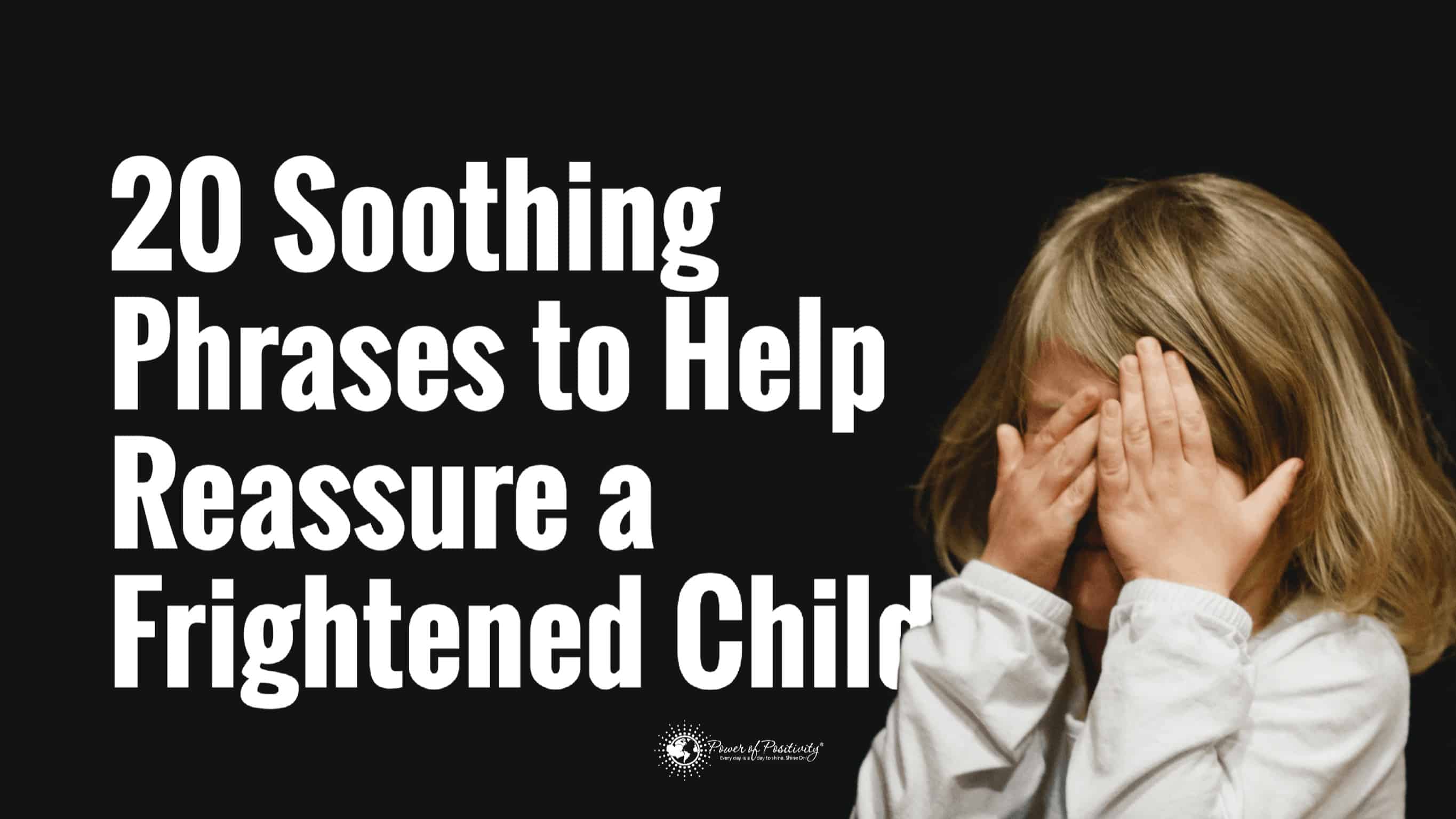When a child is frightened, finding soothing phrases to use will help calm the intense emotion.
While you would like to prevent children from ever experiencing fear, it isn’t a realistic option. Instead, you must find ways to soothe the child and help them through those moments. Soothing phrases are helpful because it allows the child to open up, and it also helps them gain perspective.
Sometimes, it is hard to find the right words to use. These soothing phrases will help you say the right thing every time, allowing you to help the child effectively.
Twenty Soothing Phrases to Help Reassure a Frightened Child
Try these to calm your little one’s frazzled nerves.
 1. Can I hug you or cuddle with you?
1. Can I hug you or cuddle with you?
When a child is frightened, physical contact can make all the difference. Always ask first because you don’t want to upset them any more than they already are. If the child agrees, go ahead and hug them or let them sit on your lap.
With a frightened child, they should be comfortable. Let them choose their position, and you adapt to them. The physical contact paired with the soothing gesture gives them a chance to feel safe and relaxed.
2. I am not going anywhere until you feel better. I am here to help.
Stay with the child until the feeling passes, and make sure they know you aren’t going anywhere. When they understand that they won’t be alone, it will help empower them to get through the situation. Ask the child what they need from you, and let them guide the experience in this way.
Not only will your presence reassure them, but asking them what they need gives them a way to control the situation. Once they feel like they are in control, they can cope with their emotions a little better.
3. Let’s make a list together of all the ways you could try to calm down.
When you help the child make a list of coping strategies, it works in a few ways. The child switches to logical thinking, which will help them see past the fear. It gives them ideas that they can use to overcome the overwhelming emotion they are experiencing.
Plus, it works as a way of making the child feel like they are regaining control. Once the list is complete, you can ask them which coping strategy they want to use. When they decide, it gives them a confidence boost and helps decrease the fear they are feeling.
4. Maybe you could draw what you are feeling.
Sometimes kids struggle to explain their feelings. Encourage the child to draw what they are feeling, and it will serve as an outlet and a method of communication. If they don’t know what to draw, suggest that they draw a monster that characterizes their feelings.
5. Sometimes, I feel scared, too, and I know that it is hard.
When a child knows that adults feel frightened sometimes, too, it’ll be easier for them to manage. Relating to the child can give them a chance to talk about their feelings. Plus, by validating their emotion, you will show that you respect them and that their feelings are okay.
6. I am proud of you no matter what happens, and I believe in you.
Children can be afraid of not making someone proud if they don’t do well. If this is the case, telling the child that you are proud of them regardless of what happens will help them feel better. Plus, adding in the note about believing in them will help get them courage, too.
7. Can you tell me how big your worry is?
This might seem like a crazy question to ask, but it helps the child verbalize their emotion. It gives you an idea of how scared they are, too. With this information, the two of you can work on a solution to figure out the rest of the details.
8. Close your eyes and imagine what I say.
Using visualization is a powerful way to reassure a frightened child. It eases anxiety and helps them imagine a safe, happy, and comfortable place. The more detailed you are in your description, the better their fear slips away.
9. Let’s listen to your favorite songs and have a dance party. We can worry later.
Give the child a way to find joy. Music helps because it helps release tension and worry. Dancing to the music will help them physically let the fear go as it releases anxiety and boosts their mood.
10. I love you, and you are safe with me.
When a child knows that they are loved, anything is easier to handle. Knowing that they are safe is just as powerful. Repeat this phrase to the child until they have calmed down, and then reassure them of it.
When a child is afraid, things seem worse than they are for them. They need comfort, safety, and love to regain control of their emotions.
 11. Ask me any questions you have, and if I don’t know the answer, we will find it out.
11. Ask me any questions you have, and if I don’t know the answer, we will find it out.
Sometimes a child is fearful because they don’t understand something or are confused about it. Telling the child that you are open to any question will give them the courage to seek answers. As they gain knowledge, their fears will ease, and they will feel much better.
Teach them that learning can help and that there is nothing wrong with asking questions. Plus, looking up the answers you don’t know will help solidify the information they have just learned.
When you admit you don’t know, either, they will feel more confident in themselves and trust you more. The child will see that you don’t always have all the answers, just like them. They will trust your information and trust you to give them the correct answers, too.
12. I always remember the time you…
Telling stories of the past will distract your child from their fear. Even better, telling stories about a time they overcame something will give them confidence. Before you know it, they will feel better and move past the fear.
13. Why do you think you are feeling this way?
When a child thinks about why they feel afraid, it can help them understand it better. Oftentimes, children don’t think of the reason for something, which is part of why the fear can be so overwhelming.
14. I want to hear how high you can count!
This phrase will distract a child from their worries and fears immediately. Another tactic of counting is to count items.
You can ask them to count the stuffed animals on their bed or the number of people wearing a hat. Look around you and find something that will take a little bit of time.
15. What is one step we can take to make the situation better?
This phrase changes the child’s mindset. Instead of being afraid and doing nothing about it, they learn to look at what they can do to make it better. Assure them that they don’t have to fix the entire situation at once, but working on the first step helps.
16. Let’s focus on breathing together.
Breathing techniques can help anyone calm down and release negative emotions. This is a strategy that adults often use, but it is just as effective for kids.
If they don’t want to do it at first, that is okay, too. You can say that you will do it anyway, but that the child doesn’t have to. Explain that you are going to take a deep breath, and they can join if they want.
By giving them a choice, you are letting them feel like they are in control of themselves. As the child watches you or even listens to you breathe, it will still have a soothing effect. You can also explain how the breathing made you feel.
17. Look at the clock and tell me when two minutes have passed.
When the child watched the clock, they will be slightly distracted from their worries. The distraction will allow them to calm their concerns for a moment. Then you can explain that just like the time on the clock passed, their bad feelings will pass, too.
18. Will you tell me all of the people that you love?
This phrase is beneficial in two ways. First, it will distract the child from their worries and help them focus on positivity. Plus, it will fill their mind with all of the people that make them feel good.
19. Tell me what you are worried will happen.
Letting the child talk through their fears can help them get it out, and it gives you an understanding. Once you know what the worry is, you can discuss the changes of that situation happening. Then, discuss the most likely outcome and the other things that could happen.
When the child begins to see all the different possibilities, they will learn that they can’t predict the future. This knowledge will ease their fear because they won’t worry so much about the worst possible outcome.
This phrase will get the child talking, and then the follow-up will help them think logically. Don’t interrupt when the child is talking because letting them get it all out can help them process it.
20. I think we should go for a walk together.
Since exercise relieves anxiety, it is a beneficial way to diminish their fears. Plus, walking together offers time to talk, too. Your child will open up more as they let their worries out.
 Final Thoughts on Soothing Phrases to Help Reassure a Frightened Child
Final Thoughts on Soothing Phrases to Help Reassure a Frightened Child
When a child is frightened, soothing them can be difficult. With these phrases, though, you will have an easier time calming the child down.
Once the child is calm, these soothing phrases will help you address the problem with the child. Helping them think the situation through helps them learn to cope. Plus, taking the time to be there for the child will benefit both of you.


















